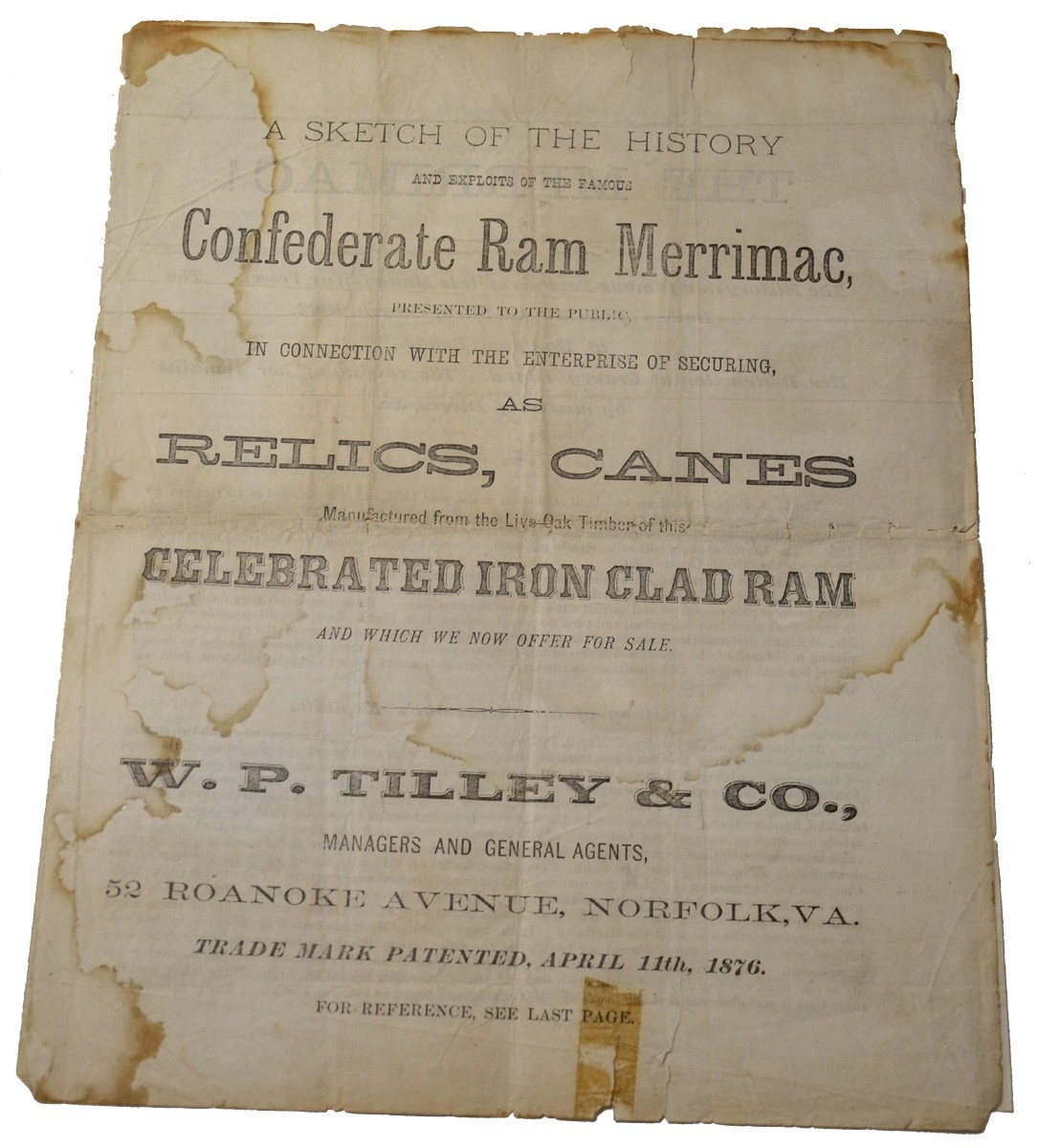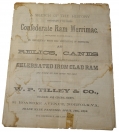site search
online catalog
SKETCH OF THE HISTORY AND EXPLOITS OF THE FAMOUS CONFEDERATE RAM MERRIMAC - 1876

$95.00 SOLD
Quantity Available: None
Item Code: 172-4699
This four- page brochure was produced by W.P. Tilley & Co. of Norfolk, Virginia, the company selling relic canes made from the wood of the USS Merrimack / CSS Virginia. The brochure gives the history of the ship, and is advertising the relic canes for sale, with references documenting their authenticity.
The USS Merrimack, also improperly spelled Merrimac, was a steam frigate, best known as the hull upon which the ironclad warship CSS Virginia was constructed during the Civil War. The CSS Virginia then took part in the Battle of Hampton Roads (also known as "the Battle of the Monitor and the Merrimack") in the first engagement between ironclad warships.
Merrimack was still in ordinary during the crisis preceding Lincoln's inauguration. Soon after becoming Secretary of the Navy, Gideon Welles took action to prepare the frigate for sea, planning to move her to Philadelphia. The day before the firing on Fort Sumter, Welles directed that "great vigilance be exercised in guarding and protecting" Norfolk Navy Yard and her ships. On the afternoon of April 17, 1861, the day Virginia seceded, Engineer in Chief B. F. Isherwood managed to get the frigate's engines lit off; but the previous night secessionists had sunk light boats in the channel between Craney Island and Sewell's Point, blocking Merrimack. On April 20, before evacuating the Navy Yard, the U.S. Navy burned Merrimack to the waterline and sank her to preclude capture.
The Confederacy, in desperate need of ships, raised Merrimack and rebuilt her as an ironclad ram, according to a design prepared by Lt. John Mercer Brooke, CSN. Commissioned as CSS Virginia on February 17,1862, the ironclad was the hope of the Confederacy to destroy the wooden ships in Hampton Roads, and to end the Union blockade which had already seriously impeded the Confederate war effort.
Later in the war, after the ports fell under U.S. control, the vessel was taken into deep water off of the Virginia coast where she was partially blown up and sank in water about thirty feet deep. After the war, the U.S. tried to raise her, but failed. Eventually private parties raised pieces of the wreck, including the oak timbers from which the canes were made.
Brochure is two sheets that are printed on both sides which measure 8 ½” by 11”. Shows water stains in areas. Edges show small tears and chipping, but item is totally readable. [SL]
~~~~~~~~~~~~~~~~~~~~~~~~~~~~~~~~~~~
THIS ITEM, AS WITH ALL OTHER ITEMS AVAILABLE ON OUR WEB SITE,
MAY BE PURCHASED THROUGH OUR LAYAWAY PROGRAM.
FOR OUR POLICIES AND TERMS,
CLICK ON ‘CONTACT US’ AT THE TOP OF ANY PAGE ON THE SITE,
THEN ON ‘LAYAWAY POLICY’.
THANK YOU!
Inquire About SKETCH OF THE HISTORY AND EXPLOITS OF THE FAMOUS CONFEDERATE RAM MERRIMAC - 1876
For inquiries, please email us at [email protected]
Most Popular
Historical Firearms Stolen From The National Civil War Museum In Harrisburg, Pa »
Theft From Gravesite Of Gen. John Reynolds »
Cavalry Carbine Sling Swivel »
Fine Condition Brass Infantry Bugle Insignia »
featured item
1847 CONGRESSIONAL RESOLUTIONS OF THANKS TO GEN. ZACHARY TAYLOR AND HIS OFFICERS AND MEN FOR MONTERREY, PERSONALLY DISPATCHED BY PRESIDENT POLK
Zachary Taylor received the formal thanks of Congress three times, along with gold medals, for victories in the Mexican War, the largest number of such resolutions and awards made by Congress to anyone. This is an official State Department copy on… (766-938). Learn More »





